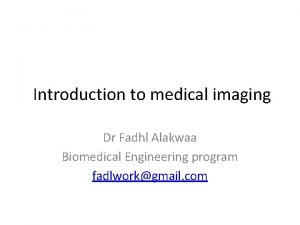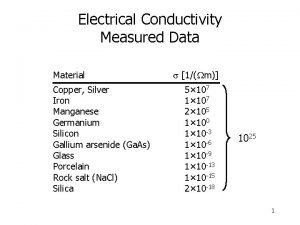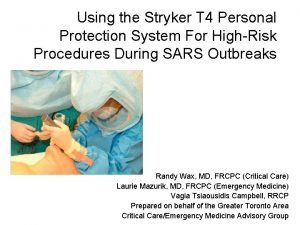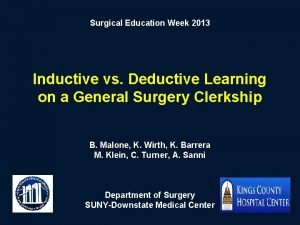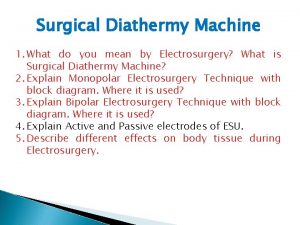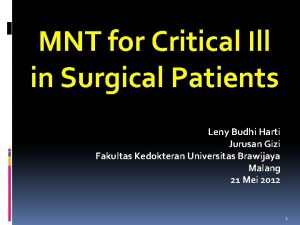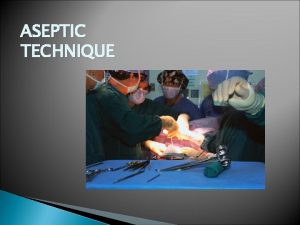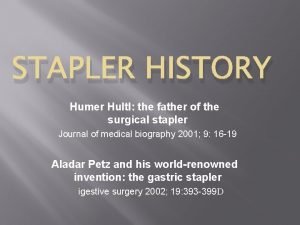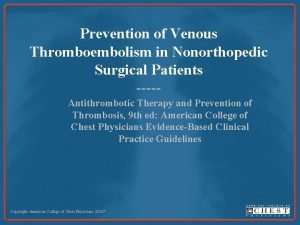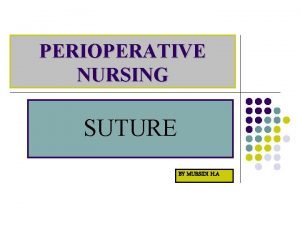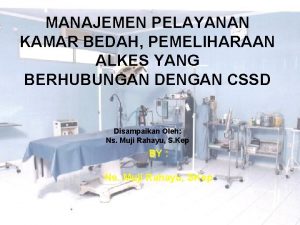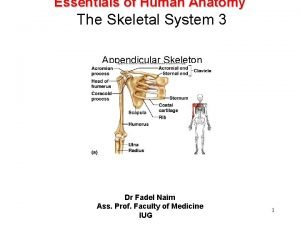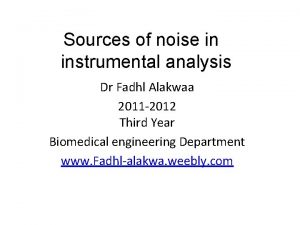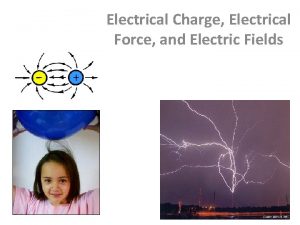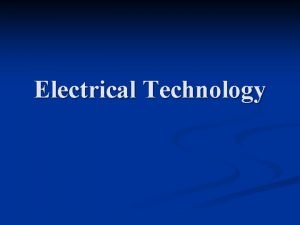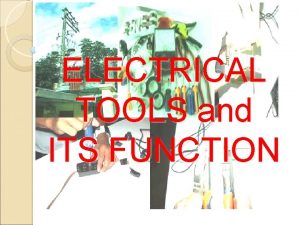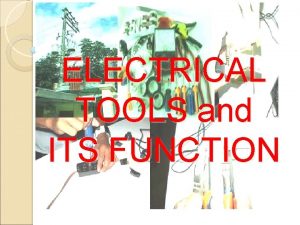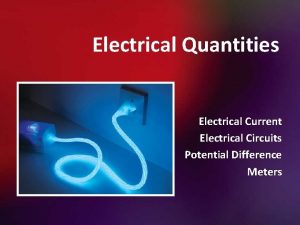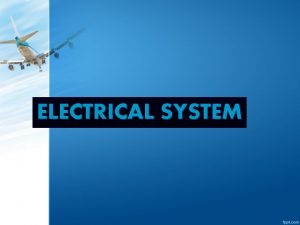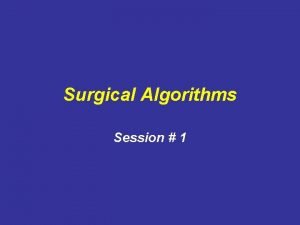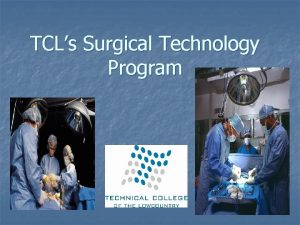Electrical Surgical Unit Dr Fadhl AlAkwaa fadlworkgmail com



































- Slides: 35

Electrical Surgical Unit Dr Fadhl Al-Akwaa fadlwork@gmail. com www. Fadhl-alakwa. weebly. com Please contact Dr Fadhl to use this material

ESU Importance • Radio frequency current has been used for many years to reduce time under anesthesia and improve the clinical result. The ability to simultaneously cut tissue and coagulate blood vessels greatly reduces morbidity and mortality, and enables a large number of procedures that are otherwise not possible, especially in neurosurgery. Please contact Dr Fadhl to use this material

AGENDA • • 81. 1 Theory of Operation 81. 2 Monopolar Mode 81. 3 Bipolar Mode 81. 4 ESU Design 81. 5 Active Electrodes 81. 6 Dispersive Electrodes 81. 7 ESU Hazards 81. 8 Recent Developments Please contact Dr Fadhl to use this material

Terminology • • • Cutting Coagulation= fulgurate + desiccation Desiccation OR contact coagulation. ﺗﺠﻔﻴﻒ : process of drying food Fulgurate: (fulgur is Latin for lightning). destroy using electricity (such as a tumor, etc. ) Hemostasis: stoppage of bleeding Blended mixed, merged, combined choice of blend waveforms to allow the surgeon to select the degree of hemostasis desired. Bleeding RF frequency 300 k. Hz and 5 MHz Cautery: process of burning or scarring with a hot iron or other implement ﺍﻟﻜﻲ Ablating: remove by cutting Please contact Dr Fadhl to use this material

Electrosurgery vs electrocautery • Electrosurgery is sometimes erroneously referred to as electrocautery. • In cauterization the essential physical mechanism behind the treatment is conduction heat transfer from a hot object placed on the surface to raise the temperature high enough to denature the tissue proteins. • Cutting and coagulation by means of electrosurgery is also accomplished by heating tissue to high temperatures, but the essential difference is that the primary mechanism is electrical power dissipation directly in the affected tissues themselves, rather than heat transfer from an external hot object on the tissue surface. Please contact Dr Fadhl to use this material

Electrosurgery vs Diathermy • Electrosurgery is also referred to as surgical diathermy, particularly in Europe. • diathermy literally means through-heating, such as might be applied in physical medicine for the relief of pain or in hyperthermia therapy for tumor treatment. • Electrosurgical devices in operating rooms are designed and built for surgical use only. Please contact Dr Fadhl to use this material

Clinical application • • • Electrosurgery is commonly used in dermatological, gynecological, cardiac, plastic, ocular, spine, ENT, Ear Nose & Throat orthopedic, urological, neuroand general surgical procedures. Please contact Dr Fadhl to use this material

Duty cycle=on time/off time • Continuous Interrupted Please contact Dr Fadhl to use this material

Crest Factor • The Crest Factor is equal to the peak amplitude of a waveform divided by the RMS value. • Electrical engineering — for describing the quality of an AC power waveform

Current density (high or low) Please contact Dr Fadhl to use this material

Electrosurgical modes Please contact Dr Fadhl to use this material

Electrosurgical modes • Monopolar mode AND Bipolar mode • The most noticeable difference between these two modes is the method in which the electric current enters and leaves the tissue. • In the monopolar mode, the current flows from a small active electrode into the surgical site, spreads through the body, and returns to a large dispersive electrode on the skin. • In the bipolar mode, the current flows only through the tissue held between two forceps electrodes. • The monopolar mode is used for both cutting and coagulation. The bipolar mode is used primarily for coagulation. Please contact Dr Fadhl to use this material

History • Development of the first commercial electrosurgical device is credited to Dr. William T. Bovie, who worked on it from 1914 to 1927 while employed at Harvard University[8] [9] • The first use of an electrosurgical generator in operating room occurred on October 1, 1926. The surgery was performed by Dr. Harvey Cushing. Please contact Dr Fadhl to use this material

Theory of Operation: Temperature • What is the general effects of heat on biologic tissue? • What happen when tissue temperature increase from normal body temperature to 45°C? • neither microscopic nor macroscopic changes, • some cytochemical changes do in fact occur. • the cells return to their normal function when the temperature returns to normal values. Please contact Dr Fadhl to use this material

Theory of Operation • What is the general effects of heat on biologic tissue? • Above 45°C, • Normal cell functions was inhibited and lead cell was death. • Further increasing the temperature up to 100°C leads to tissue drying; that is, the aqueous cell contents evaporate. This process is called desiccation. • If the temperature is increased beyond 100°C, the solid contents of the tissue reduce to carbon, a process referred to as carbonization. Please contact Dr Fadhl to use this material

Bioheat equation • Where T and To are the final and initial temperatures (K), • σ is the electrical conductivity (S/m), • ρ is the tissue density (kg/m 3) • C is the specific heat of the tissue (Jkg-1 k-1) • J is the current density (A/m 2), and • t is the duration of heat applications Please contact Dr Fadhl to use this material

Bioheat equation • The bioheat equation is valid for short application times where secondary effects such as heat transfer to surrounding tissues, blood perfusion, and metabolic heat can be neglected. • the surgeon has primarily three means of controlling the cutting or coagulation effect during electrosurgery: • the contact area between active electrode and tissue, • The electrical current density, and the activation time. • output power vs. tissue impedance Please contact Dr Fadhl to use this material

Please contact Dr Fadhl to use this material

Output values for ESUs, Please contact Dr Fadhl to use this material

Waveform Interrupted waveforms, such as exponentially damped sinusoids (obtained from spark gap or other relaxation-type oscillators) are effective for coagulation techniques requiring fulguration, or intense sparking (fulgur is Latin for lightning). Please contact Dr Fadhl to use this material Continuous sine waveforms (e. g. , those obtained from vacuum tube or transistor oscillators) have proven most effective for cutting.

Cut/Coag • Cut/Coag Most wet field electrosurgical systems operate in two modes; Cut where the tissue is vaporized and Coag where the tissue is dried. • Cut If the voltage level is high enough then the heat generated can generate a vapour pocket. The vapour pocket typically reaches temperatures of approximately 400 Degrees Centigrade which vaporizes soft tissues. • Coag When the system is operating in coag mode the voltage output is usually lower than in cut mode and less power is delivered. This therefore generates less heat and a vapour pocket is not generated. Please contact Dr Fadhl to use this material

Why high frequency? • sensitivity to electrical stimulation decreases with increasing frequency in the k. Hz range and above. • Neural and muscle cells are electrically-excitable, i. e. they can be stimulated by electric current. In human patients such stimulation may cause acute pain, muscle spasms, and even cardiac arrest. • To minimize the effects of muscle and neural stimulation, electrosurgical equipment typically operates in the radio frequency (RF) range of 100 k. Hz to 5 MHz. Please contact Dr Fadhl to use this material

high-frequency power amplifiers • vacuum tube/ spark gap 1907, Lee De Forrest, • power transistors, • solid-state electrosurgical generators(Valleylab and EMS) 1970 Please contact Dr Fadhl to use this material

ESU Design control input switches, RF Generators for Electrosurgery “high-frequency power amplifiers” safety monitor. Microcontroller Power supply Microcontroller Electrodes Active electrode return electrode, Please contact Dr Fadhl to use this material

Block diagram for typical solid state ESU Please contact Dr Fadhl to use this material

Please contact Dr Fadhl to use this material

Safety Appliances. American National Standard for Electrosurgical Devices • the return electrode losing its attachment to the skin>> skin burns at the dispersive, or return, electrode site. • Patient return monitor circuit Please contact Dr Fadhl to use this material

Electrosurgery Analyzers QA-ES Electrosurgery Analyzer Please contact Dr Fadhl to use this material

Performance testing • • • Tests include: • Automatic power distribution measurement • Crest factor measurement • RF leak measurement • Return electrode monitor (REM) test Please contact Dr Fadhl to use this material

Power Output Tests • output current (A), • power (W), • peak-to-peak voltage (V), • crest factor values. Please contact Dr Fadhl to use this material

HF Current Leakage Test • This test checks whether the active and dispersive leakage currents are within acceptable limits. Please contact Dr Fadhl to use this material

Measuring Leakage Current with HF Isolated Equipment Please contact Dr Fadhl to use this material

Measuring Leakage Current with Grounded HF Equipment Please contact Dr Fadhl to use this material

REM Alarm Test • The REM (Return Electrode Monitoring) alarm test ensures that the ESU sounds an alarm if the resistance between the two neutral electrodes exceeds its specified limit Please contact Dr Fadhl to use this material

Electrosurgery Analyzers • Typical measurement parameters: – RF current (ma) – RF power (watts) – Crest Factor (CF) – the measure of Vpeak / VRMS • 1. 414 to 1000 range – Duty cycle (pulsed waveforms) • 1% - 100% range – Through “non-inductive” test loads from 0Ω to > 5000Ω – 5 th generation parameters include • Frequency • Pulsed parameters such as time on, time off, total cycle time, duty cycle
 Fadhl alakwaa
Fadhl alakwaa Dậy thổi cơm mua thịt cá
Dậy thổi cơm mua thịt cá Cơm
Cơm A newly admitted patient was found wandering
A newly admitted patient was found wandering A nurse floats to a busy surgical unit
A nurse floats to a busy surgical unit Unit 10, unit 10 review tests, unit 10 general test
Unit 10, unit 10 review tests, unit 10 general test Principles of wires
Principles of wires Copper conductivity
Copper conductivity Unit of electrical force
Unit of electrical force Unit 33 electrical principles and wiring materials
Unit 33 electrical principles and wiring materials Gordochom precio
Gordochom precio Surgical gown
Surgical gown Vitamin abcde surgical sieve
Vitamin abcde surgical sieve Aorn skin prep guidelines
Aorn skin prep guidelines Inductive vs deductive learning
Inductive vs deductive learning Fulguration diathermy
Fulguration diathermy Surgical audit definition
Surgical audit definition Dorsal recumbent
Dorsal recumbent Nasogastrio
Nasogastrio Surgical metabolism
Surgical metabolism Surgical planning laboratory
Surgical planning laboratory Surgical metabolism
Surgical metabolism Conclusion of medical surgical nursing
Conclusion of medical surgical nursing Surgical conscience
Surgical conscience N
N Acute specific surgical infection
Acute specific surgical infection Care of the critically ill surgical patient
Care of the critically ill surgical patient Shellfish allergy and chloraprep
Shellfish allergy and chloraprep Avagard surgical scrub instructions
Avagard surgical scrub instructions Stapler history
Stapler history Surgical team roles and responsibilities
Surgical team roles and responsibilities Prevention of vte in nonorthopedic surgical patients
Prevention of vte in nonorthopedic surgical patients Surgical needle holder specialty polymers
Surgical needle holder specialty polymers Maintenance of surgical instruments
Maintenance of surgical instruments Congenital flat foot
Congenital flat foot Chapter 22 surgical asepsis
Chapter 22 surgical asepsis
